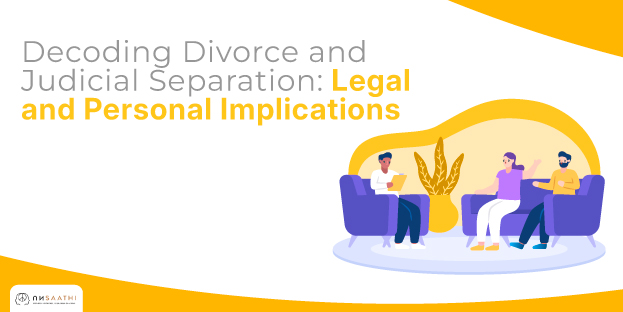When a marriage has reached a critical distress point, the words divorce and judicial separation emerge as potential solutions. Both indicate a leave from the unit of marriage but have different legal, emotional, and practical considerations. It is essential for couples to understand the differences between divorce and judicial separation since the “right” one is highly individual and depends on personal circumstances, beliefs, and future goals.
This blog will explore the definitions, legal frameworks, emotional implications, and pragmatic distinctions between divorce and judicial separation. It aims to equip you with the facts to enable you to decide which path best suits your requirements and goals.

Defining the Terms: Divorce and Judicial Separation
Divorce and judicial separation refer to a married couple no longer living together as husband and wife. But their binding and legal status of marriage differs enormously. Let’s discuss the impact of divorce and judicial separation in a couples’ life.
Divorce
Divorce, or dissolution of marriage, is the legal termination of the union of marriage. If a court issues a divorce decree, the pair is no longer legally married. They can remarry to someone else and have entirely separate lives, legally and personally.
Divorce has an official legal process that addresses issues such as property division, alimony (spousal support), child custody, and child support. The outcome of a divorce is a final, legally binding dissolution of the marriage.
Judicial Separation
In contrast, Legal or judicial separation is a legal agreement whereby a couple lives separately but is still legally married. Additionally, the rights and duties of each spouse during the period of judicial separation are specified by a court order, much like a decree in a divorce, covering matters such as where they will live, how financial support will be provided, and child custody. However, the union is not dissolved; therefore, neither can remarry. Legal separation is usually viewed as a temporary situation, a precursor to reconciliation or eventual divorce.
The Legal Framework in India: Navigating Personal Laws
In India, marriage and divorce are regulated by personal laws derived from religion. Familiarity with the applicable legal framework is necessary when contemplating divorce and judicial separation:
Hindu Marriage Act, 1955
This act applies to Hindus, Buddhists, Jains, and Sikhs. It also prescribes grounds for divorce (Section 13) and judicial separation (Section 10). Judicial separation grounds are the same as divorce grounds, like cruelty, desertion, adultery, conversion, and mental disorder. The petition for judicial separation can be withdrawn if reconciliation occurs.
Muslim Personal Law
Muslim divorce is regulated by different types of talaq (husband’s repudiation) and woman-initiated dissolution of marriage (khula, mubara’at, etc.). Although there is no direct equivalent of “legal separation” in the sense used in other laws, temporary separation may precede some types of divorce.
Indian Christian Marriage Act, 1872 and Divorce Act, 1869
These laws regulate Christian marriages and divorces. The Divorce Act prescribes grounds for dissolution of marriage and judicial separation (Section 10).
Parsi Marriage and Divorce Act, 1936
This law regulates Parsi marriages and divorces, prescribing grounds for divorce as well as judicial separation.
Special Marriage Act, 1954
This is a secular law permitting inter-religious marriages and granting grounds for divorce as well as judicial separation, which applies to all citizens irrespective of religion. The act has provisions for divorce and judicial separation. Section 27 talks about the provision of divorce, whereas section 27(2) talks about judicial separation.
Emotional Considerations: Impact of Divorce and Judicial Separation
Aside from the legal impact, the emotional effect of divorce and separation varies greatly:
Divorce
Emotionally, divorce is a deep and usually painful experience. It marks the official end of an important relationship and can precipitate feelings of grief, loss, anger, guilt, and uncertainty about the future. Though it holds the promise of a new beginning and the possibility of moving on, the permanence of divorce can be emotionally difficult for both parties and any children.
Judicial Separation
Legal separation may be less emotionally decisive. Furthermore, it may offer a time of distance and lowered conflict, enabling couples to clarify their feelings and the future of the marriage. It also presents an opportunity for reconciliation. However, the uncertainty of staying legally married and living apart can also create emotional stagnation, which also interferes with the healing process.
Practical Differences: Day-to-Day Realities
The practical effects of divorce and judicial separation also differ significantly:
Living Arrangements
In either event, the couple will be living apart. A legal separation order will usually detail the living arrangements, especially where children are involved.
Financial Issues
Both divorce and judicial separation involve the resolution of financial matters. A legal separation order will detail temporary financial support arrangements, whereas a divorce decree will finalize the division of property, spousal support, and child support.
Child Custody and Support
Arrangements for child custody, visitation, and financial support are addressed in divorce and judicial separation, prioritizing the child’s best interests.
Remarriage
It is the biggest practical distinction. Divorce formally emancipates individuals to remarry. Legal separation permits no remarriage because the bond of matrimony persists.
Taxes and Benefits
Married, separated couples are still allowed to file jointly in some jurisdictions and may retain some benefits for being married. Divorced persons report as single and forfeit these marital benefits.
Estate Planning
Divorce requires revamping estate plans, including wills and beneficiary designations. Legal separation, however, where living arrangements are kept separate but legal marital status is preserved, might still affect inheritance law unless explicitly covered in the separation agreement.
Choosing Your Path: Factors to Consider
The decision between divorce and judicial separation is a deeply personal one. These are some of the factors to consider:
Religious or Personal Belief
Religious or personal beliefs of some individuals could be against divorce, and legal separation would hence be a preferable option.
Hope for Reconciliation
If there is real hope to reconcile, legal separation gives room for this possibility without the finality of divorce.
Need for Space and Time
Legal separation can provide a temporary diminution of conflict and emotional estrangement to be able to become clear and make wise choices concerning the future of the marriage.
Financial Concerns
The short- and long-term financial implications of divorce compared to separation may differ. Such differences are paramount. As a case in point, remaining legally married can allow for qualification to receive specific healthcare benefits or taxations benefits in the short term.
Children’s Welfare
Think about what each alternative would mean for your children. Sometimes, a less acrimonious legal split may be less damaging than an angry divorce, at least in the short term. However, uncertainty over the long term can hurt as well.
Legal Advice
Seeking professional advice from a seasoned attorney is most crucial. They can interpret the very laws in your state, define your rights and obligations, and determine the legal ramifications of every choice.
Emotional Readiness
Consider your emotional readiness for finality in a divorce against the uncertainty of remaining separate.
Long-term Goals
Consider long-term goals. If remarriage or a fresh start is on your horizon, divorce is the way of expediency.
The Road to Resolution: Finding Guidance and Direction for You
No matter what you decide about divorce and judicial separation, considering expert advice and direction is essential:
Legal Advice
A family lawyer can provide valuable advice regarding your rights and options under the law, navigate the law for you, and keep your interests in good standing.
Counselling or Marriage Counseling
If reconciliation is on the horizon or if you need to work through your emotions, a counsellor or therapist can offer a safe and protected environment.
Mediation
A neutral third party can facilitate talking directly to your husband and working out mutually acceptable accommodations on money, child visitation, and other matters, potentially avoiding costly and lengthy court battles.
Financial Advisors
A financial advisor can help you understand the financial consequences of divorce and judicial separation and make plans for your future financial well-being.
Conclusion: Making the Right Choice for Your Future
The choice between divorce and judicial separation is a serious one with long-term repercussions. There is no one “right” answer; the optimum decision relies solely on your own personal situation, beliefs, emotional status, and future plans. By knowing the legal meanings, emotional connotations, and real-world distinctions between these two options and by consulting a professional, you can more clearly traverse this difficult crossroads and make an informed choice that propels you in the right direction for your future well-being. Be mindful that the concern for your emotional well-being and the best interests of any involved children should be paramount in your decision-making process.


